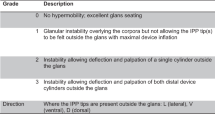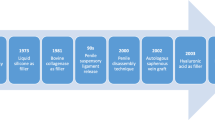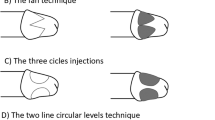Abstract
Recently, injectable hyaluronic acid gel has been widely used in soft-tissue augmentation. We performed this study to identify the feasibility of hyaluronic acid gel for the augmentation of the glans penis. In experiment I, 0.2 cm3 of hyaluronic acid gel (HA) was injected into the dermis of the glans penis of 25 New Zealand white rabbits via a 30 G needle. At 3, 7, 14, 30, and 90 days after injection, histological changes of glans were studied, respectively. In experiment II, 0.5 cm3 of HA was injected into the dermis of the glans penis of 14 Beagle dogs via a 27 G needle. At 6 months after injection, histological changes of the glans penis were also evaluated. At the time of autopsy, the lung, liver, and spleen were studied for systemic adverse reaction in each separate experiment.
In experiment I, various sized cavities filled with amorphous basophilic materials were noted in the lamina propria and corpus spongiosum of the glans penis. All implants were positively stained on alcian blue. The intensity decreased in a time-dependent manner. Until 14 days, minimal inflammatory reactions were noted, but no signs of inflammation were identified at 90 days. With the gradual decrease of inflammation, fibrosis and deposition of collagen were noted. In experiment II, implants were well maintained at 6 months after injection in the lamina propria. Grade 1 of the inflammatory reaction was noted in one case. In both the experiments, all the specimens were free from any foreign body reaction and systemic adverse reactions.
In conclusion, these results suggest that hyaluronic acid gel can be easily injected into the lamina propria of the glans penis and reside until 6 months. Injectable hyaluronic acid gel has a potential as a new bioimplant for the augmentation of the glans penis.
This is a preview of subscription content, access via your institution
Access options
Subscribe to this journal
Receive 8 print issues and online access
$259.00 per year
only $32.38 per issue
Buy this article
- Purchase on Springer Link
- Instant access to full article PDF
Prices may be subject to local taxes which are calculated during checkout





Similar content being viewed by others
References
Barton JL, Cunliff WJ . Oil granuloma. In: Rook A et al. (eds). Textbook of Dermatology. Blackwell: Oxford, 1986, pp 1870–1871.
Knapp TR, Kaplan EN, Daniels JR . Injectable collagen for soft tissue augmentation. Plast Reconstruct Surg 1977; 60: 898–905.
Comper WD, Laurent TC . Physiological function of connective tissue polysaccharides. Physiol Rev 1978; 58: 255–315.
Olenius M . The first clinical study using a new biodegradable implant for the treatment of lips, wrinkles, and folds. Aesth Plast Surg 1998; 22: 97–101.
Duranti F et al. Injectable hyaluronic acid gel for soft tissue augmentation. Dermatol Surg 1998; 24: 1317–1325.
Goa KL, Benfield P . Hyaluronic acid. A review of its pharmacology and use as a surgical aid in ophthalmology, and its therapeutic potential in joint disease and wound healing. Drugs 1994; 47: 536–566.
Elson ML . Soft tissue augmentation. A review. Dermatol Surg 1995; 21: 491–500.
Pollack SV . Silicone, Fibrel, and collagen implantation for facial lines and wrinkles. J Dermatol Surg Oncol 1990; 16: 957–961.
Larsen NE et al. Hylan gel biomaterials: dermal and immunologic compatibility. J Biomed Mater Res 1993; 27: 1129–1134.
Richter W . Nonimmunogenicity of purified hyaluronic acid preparations tested by passive cutaneous anaphylaxis. Int Arch Allergy Immunol 1974; 47: 211–217.
Richter W, Ryde E, Zetterstrom EO . Nonimmunogenicity of purified sodium hyaluronate preparation in man. Int Arch Allergy Immunol 1979; 59: 45–48.
Gibbs DA, Merrill EW, Smith KA . Rheology of hyaluronic acid. Biopolymers 1968; 6: 777–791.
Balazs EA . Intercellular matrix of connective tissue. In: Finch CE, Hayflick L (eds). Handbook of the Biology of Aging. Van Nostrand Reinhold: New York, 1977, pp 22–240.
DeVore DP, Hughes E, Scott JB . Effectiveness of injectable filler materials for smoothing wrinkle lines and depressed scars. Med Prog Technol 1994; 20: 243–250.
Author information
Authors and Affiliations
Corresponding author
Rights and permissions
About this article
Cite this article
Moon, D., Kwak, T., Cho, H. et al. Augmentation of glans penis using injectable hyaluronic acid gel. Int J Impot Res 15, 456–460 (2003). https://doi.org/10.1038/sj.ijir.3901058
Received:
Revised:
Accepted:
Published:
Issue Date:
DOI: https://doi.org/10.1038/sj.ijir.3901058
Keywords
This article is cited by
-
Hyaluronic acid injection to coronal sulcus of the penis for the treatment of premature ejaculation: a retrospective observational study
BMC Urology (2023)
-
Current and emerging treatment options for premature ejaculation
Nature Reviews Urology (2022)
-
Aesthetic Penile Augmentation Procedures: A Comprehensive and Current Perspective
Current Urology Reports (2022)
-
Hyaluronic acid injection in glans penis for treatment of premature ejaculation: a randomized controlled cross-over study
International Journal of Impotence Research (2019)
-
Complications of glans penis augmentation
International Journal of Impotence Research (2019)



